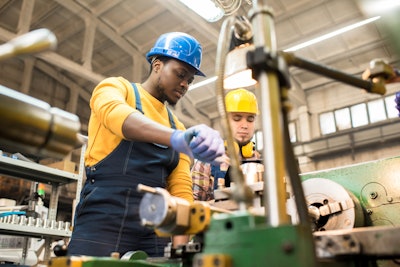
In 2025, the U.S. manufacturing industry faced a challenging economic environment: from inflation and cost of goods on the rise to low employment numbers and economical strife.
Yet, despite these challenges, there are opportunities for U.S. manufacturers on the horizon in 2026.
Here are 6 trends set to reshape the manufacturing industry in 2026, according to Deloitte.
1. Investment in smart manufacturing and operations
Investment in smart manufacturing is likely to continue in 2026 as manufacturers seek to improve competitiveness, agility, and resilience in the face of uncertainty and complexity. A 2025 Deloitte survey found that the majority (80%) plan to invest 20% or more of their improvement budgets in smart manufacturing initiatives, with a focus on foundational tools and technologies. These include automation hardware, data analytics, sensors, and cloud computing.
2. New digital tools to offer transformative solutions
The shifting trade and tariffs landscape has resulted in uncertainty and increased costs for U.S. manufacturers in 2025, and companies have responded with a variety of strategies, from front-loading inventory to reevaluating the structure of their supply chains.
Despite these efforts, 78% of manufacturers responding to the National Association of Manufacturers’ “2025 third quarter manufacturers’ outlook survey” reported that trade uncertainty remains their top concern, and they expect input costs to increase by an average of 5.4% over the next year.
However, the future could bring greater trade certainty. The United States has brokered tariff agreements with the United Kingdom, Vietnam, Japan, Indonesia, the Philippines, South Korea, and the European Union, and additional deals could follow.
3. New incentives, the data center boom, and continued demand for semiconductors could drive investment and growth
Respondents to a survey conducted by the Reshoring Initiative indicated that several factors—including some influenced by U.S. policy—could encourage further reshoring to the United States. These include a larger pool of highly skilled U.S. workers, a weaker dollar, lower corporate tax rates, regulatory reform, and 15% additional tariffs applied to all imports from all countries.
Recent policy changes seek to further investment incentives. The One Big Beautiful Bill Act, for example, retained the corporate tax rate (21%) set by the 2017 Tax Cuts and Jobs Act and made permanent other tax-saving provisions, such as full expensing for new equipment and immediate expensing of domestic research and development.
Data center growth is already creating substantial demand and driving significant investment, and this is expected to continue in 2026. For instance, startups focused on small modular reactors attracted $3.9 billion in funding in 2024, a tenfold increase from 2023.
4. Agentic aftermarket services could transform the customer experience
Aftermarket services can be an important revenue source and profit driver for industrial manufacturers, delivering margins that are more than two times higher than equipment sales alone. They can also create predictable, less cyclical revenue streams and strategic differentiation, which could be essential for remaining competitive during economic uncertainty.
New tools such as agentic AI are also poised to help manufacturers take their aftermarket services to the next level. A key goal for aftermarket services is to move toward proactive planning, ensuring the right expertise, parts, and tools are available at the point of service when required.
5. An adaptive workforce planning framework could help address uncertainty and increasing skill requirements
The competition for skilled labor remains intense, especially as manufacturers invest in advanced digital tools and smart manufacturing facilities. The skill sets that companies require may also shift if they adjust their product portfolios to maximize profitability in response to fluctuating tariff costs. And if the trend toward reshoring accelerates—even if companies leverage existing U.S. capacity—the supply of skilled workers could become increasingly strained.
The potential for ongoing economic uncertainty in 2026 could compound these challenges. Demand volatility and modifications to new facility construction timelines can cause unpredictable and rapid changes in manufacturing labor needs. However, the long lead times required to hire and train new workers can make it difficult to effectively respond to these swings.
Manufacturers could also leverage technology to enhance their talent sourcing, screening, and training processes, including a shift to granular, skills-based workforce modeling and planning.



















